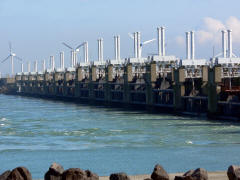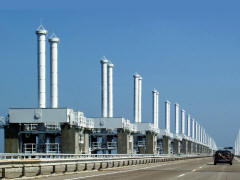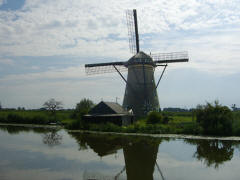Page 1 2 3 4 5 6 7 8 9 10 11 12 13 14 15 16 17
Wednesday, 5 August. We woke up in Rotterdam with the
ship docked at the Red Bridge. It was another beautiful day. Jane was feeling
much better and insisted on going on the optional Delta Works tour we had
signed up for. The Delta Works are a series of dams, dikes, and storm surge
barriers built
in the southwest Netherlands over a period of nearly 50 years (1950-1997).
The bus left at 8:30 for Zeeland and we arrived at the Waterland Neeltje Jans visitor center for the Eastern Schelde storm surge barrier about 10:00. We walked among the many exhibits in the center, then watched a movie on the construction, installation, and operation of the barriers. Each section, built and installed separately, has a huge sluice gate type door. The door is normally open, but can be closed under adverse weather conditions. In this way, normal tidal flows continue and the saltwater marine life behind the barrier is preserved.
After the movie we went outside and looked at more exhibits until it was time to board the bus again. We drove a short way to the near end of the barrier, then walked down a ramp and went inside the structure. A local guide was explaining the barrier when Jane suddenly told me she felt faint. I barely had time to hold her before she collapsed, and I lowered her to the floor. An ambulance was called and arrived in a few minutes. Jane had regained consciousness but, after some discussion, she agreed to be taken to the hospital in Goes (pronounced Hoose), about 15 miles away. Meanwhile, our bus left to return to the ship, but the Tour Director who had been with the group stayed with Jane and me.
After three hours or so, Jane was released from the hospital.
By sheer coincidence, the Tour Director lived in Goes and had her car there.
She arranged for a nephew to bring her car to the hospital to pick us up, then
drive us the Kinderdijk (70 miles away) where the ship had moved while we were
gone. We got there about 4:45, shortly after the guided walking tour was over.
Kinderdijk is a village in a polder (a low-lying tract
of land enclosed by dikes) at the confluence of two rivers. To drain the
polder, a system of 19 windmills was built around 1740. This is the
largest concentration of old windmills in the Netherlands. The name
means "child dike" and, according to legend, dates back to a devastating
flood in 1421. When the storm subsided, a baby in a cradle was found
floating in the water.
We had been very eager to see Kinderdijk's
windmills and the driver was kind enough to stop at a couple of places along
the road where there were good views of them so Jane could see them.. Once we
got to the ship, I took
her to our room to rest,
then rushed out to explore the area on my own. Even moving at a comfortable pace, it was easy to walk through
the whole area in a little over an hour.
I was back on board the Rhapsody by 6:30. It sailed for Nijmegen at 7:00, just as dinner was served. Jane again had a simple meal brought to our room, but I ate in the dining room. Page 1 2 3 4 5 6 7 8 9 10 11 12 13 14 15 16 17
Copyright © 2000-2023 DarrellPeck.com All rights
reserved. | ||||||||





